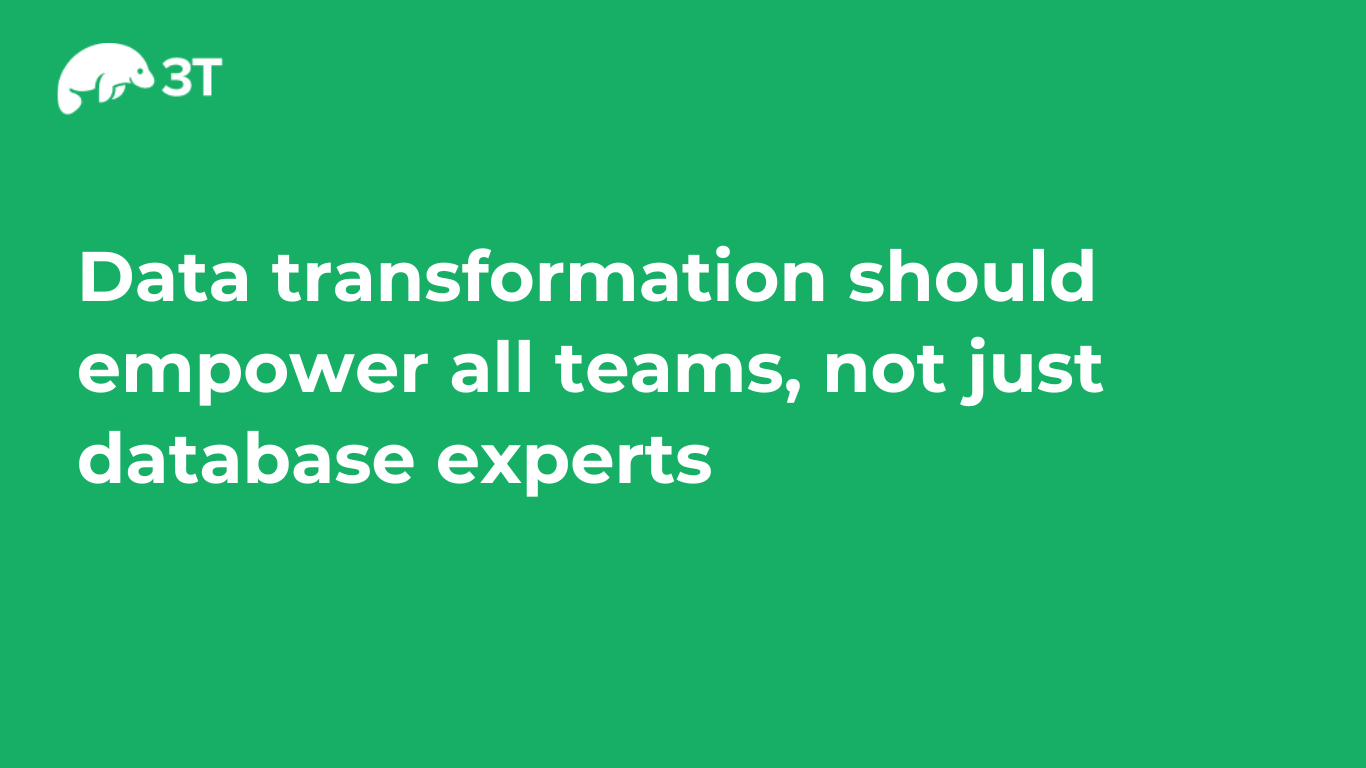Savvy business leaders know their enterprise data is a major asset. However, Deloitte research found more than two thirds (67%) of senior leaders aren’t comfortable accessing or using their data. Organizations that are serious about getting the best possible results from MongoDB need to make sure their data transformation strategies focus on allowing everyone to interact with data in ways that make sense for their role. This ease of access can turn raw data to usable data and help you confidently make data-driven decisions.
As a NoSQL database, MongoDB is a scalable and flexible option that, when used correctly, can play a vital role in your enterprise data transformation. Let’s explore some of the ways you can maximize its value.
Why you should prioritize MongoDB data transformation
If your business generates large volumes of data from a range of sources then a structured MongoDB data transformation strategy is essential.
For many, this makes MongoDB an attractive option as it stores data as BSON (Binary JSON) documents, meaning raw data can be ingested and stored without predefined structures. While this is useful, additional work is sometimes needed to gain valuable insights.
This is why data cleaning, structuring, and optimization of MongoDB performance should be part of your enterprise data transformation strategy. Without these, you run the risk of inconsistencies, inefficiencies, slow queries, data silos, inconsistent reporting, missed opportunities, and reduced competitiveness in an increasingly data-driven world.
Thankfully, the right tools can simplify data workflows and help you get your MongoDB data transformation strategy right, which can:
- Increase operational efficiency
- Improve business insights
- Support scalability to support growth
- Enhanced AI and analytics capabilities

MongoDB data transformation strategies
1. Simplify data exploration
The ability to explore data quickly and flexibly is an important part of any MongoDB transformation strategy. Without this, businesses may find their teams waste time manually searching and analyzing data. It can also make it more difficult to identify trends and patterns and leave you at risk of making decisions based on outdated or incomplete insights.
Querying tools can play a huge part in empowering teams to explore data, allowing them to write better queries faster to accelerate development cycles and reduce change failure rates. These can offer your team the ability to prototype and convert queries efficiently from MongoDB syntax to JavaScript, as well as visualize data patterns to identify opportunities and anomalies.
2. Optimize query performance to remove bottlenecks
Slow-running queries can significantly impact productivity, delaying reports, dashboards, and real-time analytics that businesses rely on. Performance bottlenecks can result in inefficiencies and frustration across teams, particularly in fast-moving industries where data needs to be accessible instantly.
Neglecting query performance optimization can lead to increased downtime and lost revenue due to system slowdowns and higher infrastructure costs due to inefficient scaling. It can also cause frustration among developers and data teams, reducing productivity and innovation.
Performance tuning and debugging are essential for efficient MongoDB data transformation as these help to find and fix slow-running queries to reduce change failure rates and increase deployment frequency. They can also identify performance bottlenecks before they impact your insights, and make consistent data quality easier to achieve thanks to efficient indexing and schema validation.
3. Make data migration, import, and export seamless
Successful data migrations are essential to make sure your organization makes the most of technology, can adapt to changing business needs and meets regulatory requirements.
But transferring data between systems can be a complex process, meaning it’s a problem many organizations struggle with. Badly managed migrations can lead to errors, data loss, inconsistencies, and even compliance risks due to improper data handling. It can also create an unwanted dependency on technical teams for tasks like basic data retrieval.
For business leaders, this can cause a lack of trust in your data and impact decision making.
But there’s no need to let common migration blockers hold back your business. A structured approach to data migration and the right tools will let you export, clean, and transform NoSQL data with full control, so it’s ready for integration, analysis, or review.
They can also reduce manual errors and simplify data extraction for stakeholders who lack direct database access.
4. Empower true collaboration across teams
Data transformation should empower all teams, not just database experts. Those who want the best results from MongoDB know lots of people will need to interact with it. That means using tools that make sure no specialist skills are needed to work with MongoDB. Failing to ensure this can lead to friction and hold back collaboration across teams, skills gaps, errors and even leave you at risk of failing to meet compliance requirements.
A lack of collaboration and accessibility can also result in a slow response to market changes, wasted resources as teams spend unnecessary time searching for or cleaning data and a fragmented data ecosystem where different departments operate with inconsistent information.
Features like team sharing can help you organize your queries, scripts and connections, and share them with your co-workers quickly and securely, making MongoDB data accessible and usable across departments. This allows everyone on your team, regardless of MongoDB experience, to easily interact with the data in ways that make sense for their role.

Kickstart your MongoDB data transformation with the right tools
Raw data holds immense value, but only when transformed into actionable insights. By leveraging MongoDB’s scalability alongside powerful transformation tools, you can improve efficiency, decision-making, and get more from your data.
To maximize MongoDB’s potential for your organization, look for tools that offer flexibility, efficiency, and standardization. That means simplifying complex data tasks with speed and accuracy, providing you full control over data operations, and allowing you to scale MongoDB effortlessly as needs change.








